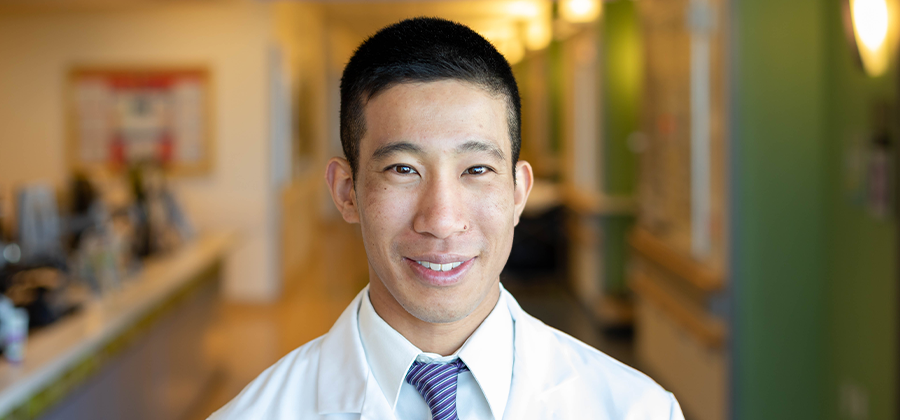Writing the Book on Teens and Social Media
An Interview with Jason Nagata, MD, MSc

Dr. Jason Nagata, adolescent medicine specialist at UCSF Benioff Children’s Hospitals, has led groundbreaking studies on eating disorders in underserved populations and social media use among teens. Currently, he is developing comprehensive national guidelines focused on adolescents and social media. His work has been featured in The New York Times and on NPR, CNN, and NBC News.
You literally wrote the book on eating disorders in teenage boys. What inspired you?
When I was a medical student working in UCSF's Eating Disorders Program, my first patient was a 16-year-old male wrestler. I was trying to read the then-current guidelines about how to take care of him, but there was very little specificity about boys because most of the research was on girls. I started doing that research myself, and after about a decade, I was able to update the medical guidelines on adolescent eating disorders to include specific considerations for boys and men.
That experience really showed me how important it is to conduct research and develop evidence that can inform clinical guidance for pediatricians. Physicians use these guidelines to make decisions about treatment and management every day, and they really have an impact on the quality of patient care.
What led you from eating disorders to social media?
My initial research into social media was through the lens of eating disorders: How does social media use lead to or worsen eating disorder symptoms? I was seeing this firsthand with some of my patients; the constant comparisons to unattainable body ideals and the pressure to show off their bodies to gain likes and followers was giving rise to low self-esteem and poor body image.
I started conducting studies on the topic and gained access to the Adolescent Brain Cognitive Development study, the largest study on brain health and child development in the U.S. It started following 12,000 9- and 10-year-olds in 2016 and has continued to this day, collecting a huge amount of data on contemporary adolescents, their exposure to screens, and their mental and physical health. It’s basically the perfect dataset for studying the effects of social media over time.
What are some key findings from your research?
Let me start by saying that social media itself isn’t inherently good or bad. There are positive ways that teens can use social media — for connection, communication, or education. But there are also risks related to excessive use. Our team has shown that social media is a risk factor for the development of depression. Excessive use can also crowd out healthy activities like exercise, time spent outdoors, face-to-face connections, and sleeping — all of which are vital to mental health.
For me, social media is one of the most impactful issues we can focus on to support adolescent health.
There are also elements of addiction in excessive social media use, including symptoms of withdrawal, tolerance, and relapse, which can be similar to addictions to substances like alcohol. We found that 48% of 11- and 12-year-olds report losing track of how much time they spend on their phones, 25%say they’re using social media to forget about their problems, 17% say they are trying to reduce their social media use but cannot, and 11% say that screen time or social media use has negatively affected their schoolwork.
How will these findings inform the national guidelines you’re developing on teens and social media?
There are currently no national medical guidelines focused on adolescents and social media. The American Academy of Pediatrics does have general screen time guidelines, but they’re not specific to social media or adolescent age groups. There is also no formal diagnosis for social media addiction. My goal is to leverage these findings to create practical, actionable, personalized, age-specific advice for parents, teachers, and pediatricians on how to help teens optimize their social media use while minimizing risks and harms. I also want to formalize a diagnosis for social media addiction.
Why is this work so important?
We already know that more than 90% of teens are on social media, and that number is increasing. Over a three-year period, when participants were between the ages of 10 and 13, average daily social media use increased tenfold, from 7 minutes to 73. For me, social media is one of the most impactful issues we can focus on to support adolescent health. We have guidelines on tobacco and alcohol, but because social media is relatively new, with relatively little data, we don’t have guidelines yet, despite this being one of the top concerns of today’s caregivers.
What are your next steps?
Philanthropy will be essential to our ability to finalize this research and launch these guidelines. UCSF has been at the forefront of this work. We have a track record of publishing some of the seminal studies on this topic, and this is such a special place to do this kind of interdisciplinary research with so many global experts. Donor support is crucial to our ability to create robust national guidelines that are personalized for teens of different ages, backgrounds, and experiences, and then get the message out there.
To learn more about how you can support Dr. Nagata’s work, contact Allyson Hamilton at [email protected].